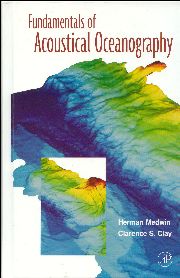
Acoustical Oceanography
Academic Press, 1998, 712 pages
H. Medwin and C. S. Clay

|
 ince light travels only a few meters in the
ocean, oceanographers use sound waves, ranging
from a few hundred Hertz to upwards of 1 MHz to obtain images
of ocean phenomena. This book, written by renowned experts in
the field, discusses sound propagation, ray paths, attenuation,
cavitation, waveguides, and scattering. Sonar does much more
than simply bounce off submarines in grade B movies. Sound
waves undergo bending, refraction, interference, absorption
and scattering as they interact with fish, plankton, and the
millions of bubbles in the ocean. Their absorption by magnesium
sulfate and borate salts makes the acoustical properties of ocean
water quite different from pure water.
ince light travels only a few meters in the
ocean, oceanographers use sound waves, ranging
from a few hundred Hertz to upwards of 1 MHz to obtain images
of ocean phenomena. This book, written by renowned experts in
the field, discusses sound propagation, ray paths, attenuation,
cavitation, waveguides, and scattering. Sonar does much more
than simply bounce off submarines in grade B movies. Sound
waves undergo bending, refraction, interference, absorption
and scattering as they interact with fish, plankton, and the
millions of bubbles in the ocean. Their absorption by magnesium
sulfate and borate salts makes the acoustical properties of ocean
water quite different from pure water.
Animals, of course, use sound as well. Dolphins, for example, emit clicks at 100 kHz and up to 226 dB, well above the level that would cause cavitation if the sound wave were continuous.
This book is intended to be used as a textbook for geophysicists, oceanographers, and acoustical engineers. Uses calculus and matrix algebra.
